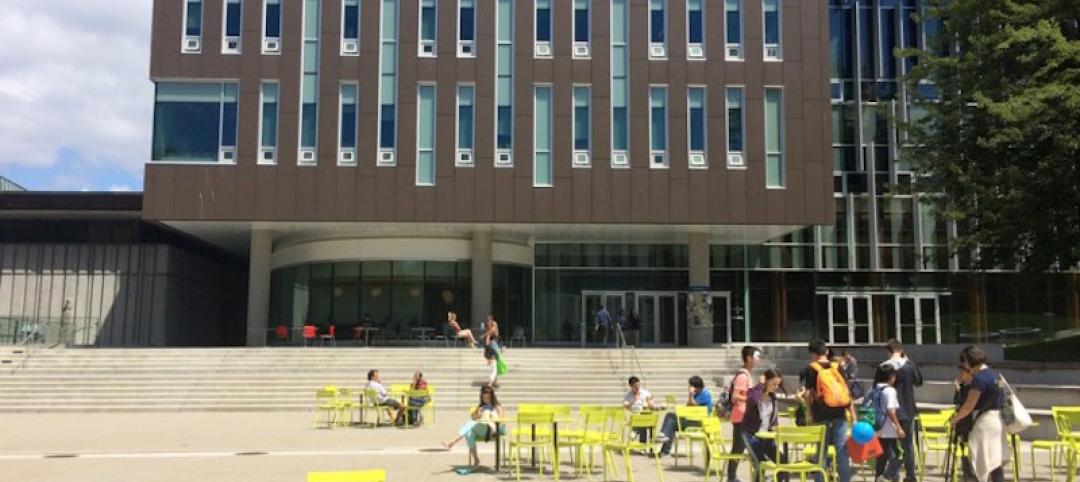Campus construction and renovation projects often come with hefty price tags. A few years ago, Duke University spent nearly $80 million on a new dining hall. Two recent projects that SmithGroupJJR designed include the $50 million Mike Ilitch School of Business at Wayne State University, now under construction in downtown Detroit, and the $82 million, 188,000-sf University of Wisconsin–LaCrosse Instructional Science Facility, a combination of allied health and STEM that will open next year.
As colleges sign off on ever-more-extravagant physical plant to help in their recruitment efforts, tuition hikes are putting college beyond the financial reach of the high school students they are trying to attract.
But colleges and universities are adept at tapping a variety of sources—taxpayers, investors, donors, and, yes, students—to fund their growth ambitions.
Bonds are one time-tested route. The University of New Mexico’s five-building construction program is being paid for primarily with bonds. Last year, North Carolina completed a $2 billion issue of Connect Bonds, $1.33 billion of which are earmarked for the 17 colleges in its UNC system.
Other colleges are asking their student bodies to approve annual user fees that would defray the cost of planned construction and renovation before the work gets started.
 The University of New Mexico’s five-building construction program is being financed by a combination of bonds, student fees, school funds, and private donations. Courtesy University of New Mexico.
The University of New Mexico’s five-building construction program is being financed by a combination of bonds, student fees, school funds, and private donations. Courtesy University of New Mexico.
State governments are also willing to finance college construction, albeit on a limited basis. Supplemental funding by the Massachusetts State Legislature helped pay for the $52 million, 87,500-sf Design Building at the University of Massachusetts Amherst, which had its official ribbon cutting in April. This is the first cross-laminated timber academic building in the U.S.
Greggrey Cohen, Simpson, Gumpertz & Heger’s National Practice Leader for structural repair and rehabilitation, who worked on the UMass Design Building, says that in recent years there has been a “big push” among colleges and universities in the Bay State to replace older buildings.
“The underlying strategy of our capital plan is to target investment in the areas of the highest impact, while balancing these investments across deferred maintenance, modernization, and new construction,” says Shane Conklin, UMass’s Associate Vice Chancellor for Facilities and Campus Services. Construction projects scheduled to open in the next two years include the relocation of a physical sciences building that will be integrated with a new 95,000-sf research building for chemistry and physics.
This isn’t to say that colleges and universities have unlimited access to capital. And their “reno-first” inclinations are a sign of their budgetary constraints.
“Everyone is still money conscious,” says Robert Quigley, of Architectural Resources Cambridge. His firm went through numerous meetings with Bentley University’s board before its Jennison Hall renovation budget got approved. “They are also conscious of the mistakes they made in the past being cheap,” he says. “They want to do a quality job.”
Related Stories
Energy Efficiency | Dec 13, 2016
A Massachusetts college now features the largest zero-net-energy academic building in Northeast
Bristol Community College wants to be carbon neutral by 2050.
Higher Education | Dec 8, 2016
A STEM-focused building creates a new axis on the campus of Lawrence Technological University
A giant carbon-fiber orb is a focal point for the Michigan-based school.
Higher Education | Nov 17, 2016
Construction begins on the U.S. Naval Academy’s new cyber studies and computer science department building, Hopper Hall
The building marks the first purpose built structure for cyber studies based at an academy.
Higher Education | Nov 9, 2016
Social connection in academic and student housing environments
Universities value an active and vibrant campus, and wish to create places that welcome newcomers and offer support.
Higher Education | Oct 20, 2016
Designing innovative campuses for tomorrow's students
Planning for places that foster effective innovation is still an emerging process, but the constant pressure on universities to do so continues from two of their key institutional constituencies—students and employers, writes Perkins+Will's Ken Higa and Josh Vel.
University Buildings | Sep 12, 2016
The University of Chicago’s newest residence halls are designed to be more like home
Abundant common spaces give students more chances to interact.
Education Facilities | Sep 9, 2016
Education Facility Design Award winners: The AIA Committee on Architecture for Education honors 12 projects
The best new learning centers showcase latest design trends in education.
University Buildings | Aug 17, 2016
Supporting communities of motivated learners: reflections on SCUP-51
The two themes that were consistently woven into different topics were institutional transformation and connection with students.
University Buildings | Aug 16, 2016
New images of Rice University’s Moody Center for the Arts revealed by Michael Maltzan Architecture
The arts center will foster creativity for making and presenting works across all disciplines
| Aug 10, 2016
UNIVERSITY GIANTS: Facing money woes, the nation's colleges double down on innovative ideas
Budget constraints are compelling some public institutions to pursue alternative methods of financing their major building projects.

















